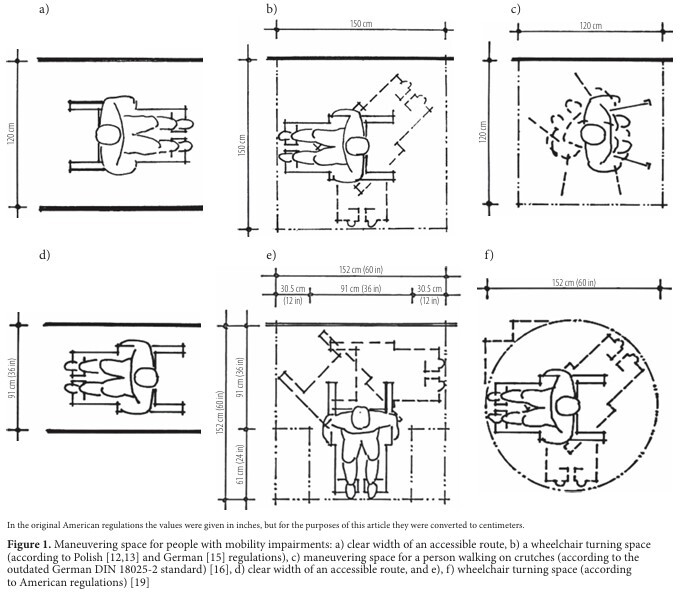Online first
Bieżący numer
Archiwum
Najczęściej cytowane 2024
O czasopiśmie
Zespół Redakcyjny
Komitet Redakcyjny
Polityka prawno-archiwizacyjna
Kup czasopismo
Klauzula informacyjna o przetwarzaniu danych osobowych
Deklaracja dostępności
Instrukcje dla Autorów
Instrukcje dla Recenzentów
Polecamy
Kontakt
Recenzenci
2024
2023
2022
2021
2020
2019
2018
2017
2016
2015
2014
2013
Redakcja i tłumaczenia
PRACA ORYGINALNA
Designing movement space for elderly and disabled people in the construction law in selected countries
1
Wroclaw University of Science and Technology, Wrocław, Poland
(Faculty of Architecture)
Zaznaczeni autorzy mieli równy wkład w przygotowanie tego artykułu
Data publikacji online: 14-06-2024
Autor do korespondencji
Przemysław Nowakowski
Wroclaw University of Science and Technology, Faculty of Architecture, Prusa 53/55, 50-317 Wrocław
Wroclaw University of Science and Technology, Faculty of Architecture, Prusa 53/55, 50-317 Wrocław
Med Pr Work Health Saf. 2024;75(3):189-97
SŁOWA KLUCZOWE
DZIEDZINY
STRESZCZENIE
Background: Building law regulations determine designing the built environment recognising the needs of users of different ages and psychophysical abilities. Seniors and their spatial needs are covered there to a limited extent. The benchmark for design are wheelchair users. Their spatial requirements are greater in relation to independent walkers, including most older people. This makes it difficult to adapt the whole built environment to the needs of people with less mobility dysfunction. This can be considered in terms of spatial design and investment costs. Material and Methods: The paper analyses the building regulations of 3 countries in terms of legal conditions to shape the architectural movement space of older people and disabled people. Analytical and comparative methods are used. Such research is becoming relevant and necessary. The analyses are conducted in the context of ageing populations. They are justified by statistical data on the age groups of Polish society. This is followed by design analyses of the legal requirements in the wheelchair movement space and proposals for alternatives, e.g., people walking with canes (case study). Their aim is to indicate methods to limit excessive communication spaces in buildings while maintaining functional values for all users. Results: Research may show the possibility of greater diversification of regulations and alternatives to current laws. They are dedicated to participants in investment processes to shape accessible buildings. They can also be used in legislative work on amendments to the construction law. Conclusions: Changes in building regulations and a detailed approach to the mobility needs of older and disabled people (walking independently) are proposed. These decisions can provide benefits (spatial and economic savings). They fall into the “design for all” trend and sustainability of the built environment. These demands are based on no longer valid normative regulations. Med Pr Work Health Saf. 2024;75(3):189–197
Udostępnij
ARTYKUŁ POWIĄZANY
Przetwarzamy dane osobowe zbierane podczas odwiedzania serwisu. Realizacja funkcji pozyskiwania informacji o użytkownikach i ich zachowaniu odbywa się poprzez dobrowolnie wprowadzone w formularzach informacje oraz zapisywanie w urządzeniach końcowych plików cookies (tzw. ciasteczka). Dane, w tym pliki cookies, wykorzystywane są w celu realizacji usług, zapewnienia wygodnego korzystania ze strony oraz w celu monitorowania ruchu zgodnie z Polityką prywatności. Dane są także zbierane i przetwarzane przez narzędzie Google Analytics (więcej).
Możesz zmienić ustawienia cookies w swojej przeglądarce. Ograniczenie stosowania plików cookies w konfiguracji przeglądarki może wpłynąć na niektóre funkcjonalności dostępne na stronie.
Możesz zmienić ustawienia cookies w swojej przeglądarce. Ograniczenie stosowania plików cookies w konfiguracji przeglądarki może wpłynąć na niektóre funkcjonalności dostępne na stronie.






